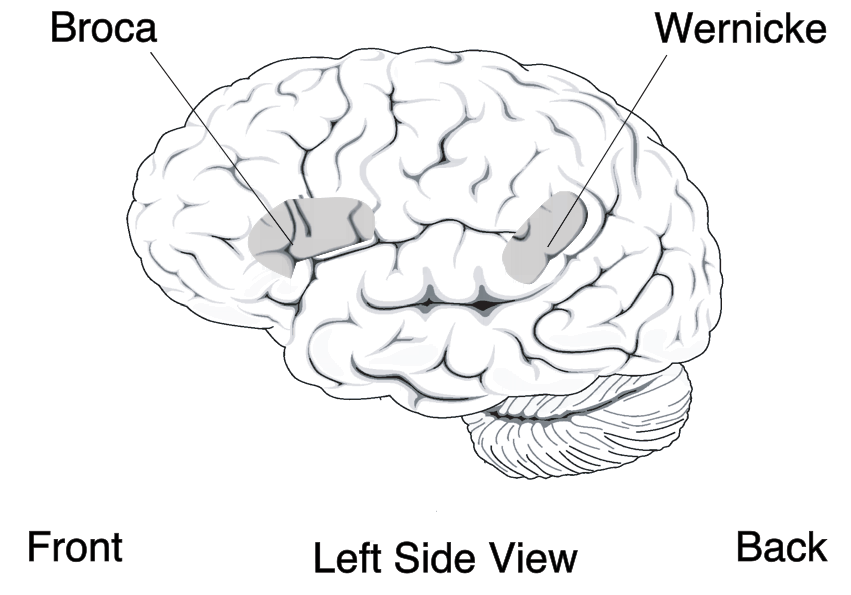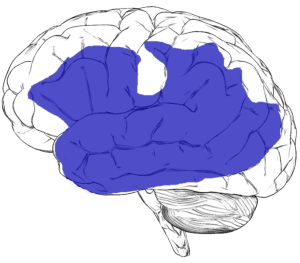Chapter 11: Hearing in Complex Environments
11.8. Language Cortex
Anyone who has tried to master a second language as an adult knows the difficulty of language learning. And yet children learn languages easily and naturally. Children who are not exposed to language early in their lives will likely never learn one. Case studies, including Victor the “Wild Child,” who was abandoned as a baby in France and not discovered until he was 12, and Genie, a child whose parents kept her locked in a closet from 18 months until 13 years of age, are (fortunately) two of the only known examples of these deprived children.
Both of these children made some progress in socialization after they were rescued, but neither of them ever developed language (Rymer, 1993). This is also why it is important to determine quickly if a child is deaf and to begin immediately to communicate in sign language. Deaf children who are not exposed to sign language during their early years will likely never learn it (Mayberry, Lock, & Kazmi, 2002).
For the 90% of people who are right-handed, language is stored and controlled by the left cerebral cortex, although for some left-handers this pattern is reversed. These differences can easily be seen in the results of neuroimaging studies that show that listening to and producing language creates greater activity in the left hemisphere than in the right. However, the right hemisphere is important for understanding and producing the emotional content of speech and for understanding and producing non-literal speech, which is important in humor.
Broca’s area, an area in front of the left hemisphere near the motor cortex, is responsible for language production (Figure 11.12, “Drawing of Brain Showing Broca’s and Wernicke’s Areas”). This area was first localized in the 1860s by the French physician Paul Broca, who studied patients with lesions to various parts of the brain. Wernicke’s area, an area of the brain next to the auditory cortex, is responsible for language comprehension (Figure 11.12).
Evidence for the importance of Broca’s and Wernicke’s areas in language is seen in patients who experience aphasia, a condition in which language functions are severely impaired. The main causes of aphasia is a cerebral vascular accident (stroke) or any sort of head trauma. However aphasia can also be a result of brain tumors, brain infections, or a neurodegenerative disease. There are three primary kinds of aphasia, which include expressive, receptive, and conduction aphasia (see Figure 11.13).
Expressive aphasia, also known as Broca’s aphasia, is characterized by the partial or full loss of the ability to produce language. This includes spoken, manual, or written language. Although expressive language can be extremely difficult, the ability to understand and comprehend language remains intact. Individuals with this type of aphasia usually will be able to read, however, since the ability to produce language is impaired, writing is usually limited because of the brain’s inability to produce language in the form of writing.
Receptive aphasia, also known as Wernicke’s aphasia, is characterized by difficulty understanding written and spoken language, although other intellectual abilities are completely fine. This type of aphasia also causes an individual’s speech to be difficult to understand. What this means is they can speak in correct grammatical and syntactical sentences, but it doesn’t make a lot of sense. Because Wernicke’s aphasia affects the brain’s ability to make sense of words, reading and writing are often severely impaired.
Conduction aphasia is characterized by impairment with repetition. These individuals are able to express themselves relatively well, with only some word-finding issues, but have extreme difficulty repeating phrases, especially when they increase in length and complexity. This type of aphasia is much more rare than the other two types listed above.

Supplemental Information:
- “Aphasia can also be the result of brain tumors, epilepsy, autoimmune neurological diseases,[4] brain infections, or neurodegenerative diseases (such as dementias)”
- “Broca’s area, or the Broca area is a region in the frontal lobe of the dominant hemisphere, usually the left, of the brain with functions linked to speech production.”
- “Wernicke’s area, also called Wernicke’s speech area. It is involved in the comprehension of written and spoken language, in contrast to Broca’s area, which is primarily involved in the production of language.”
- Figure:

Figure 11.13. Regions of the left hemisphere that can give rise to aphasia when damaged (schematic diagram based on findings of I. Henseler, F. Regenbrecht, H. Obrig, 2014). DOI: 10.1093/brain/awt374 (Credit: User Bertyhell on Wikicommons, License: CC BY-SA 3.0) - “For example, in the following passage, a patient with Broca’s aphasia is trying to explain how he came to the hospital for dental surgery:”Yes… ah… Monday… er… Dad and Peter H… (his own name), and Dad…. er… hospital… and ah… Wednesday… Wednesday, nine o’clock… and oh… Thursday… ten o’clock, ah doctors… two… an’ doctors… and er… teeth… yah
- People have frequent errors during spontaneous speech, such as substituting or transposing sounds. They are also aware of their errors and will show significant difficulty correcting them.[3]For example:Clinician: Now, I want you to say some words after me. Say ‘boy’.Aphasic: Boy.Clinician: Home.Aphasic: Home.
Clinician: Seventy-nine.
Aphasic: Ninety-seven. No … sevinty-sine … siventy-nice…
Clinician: Let’s try another one. Say ‘refrigerator’.
Aphasic: Frigilator … no? how about … frerigilator … no frigaliterlater … aahh! It’s all mixed up! [4]
CC LICENSED CONTENT, SHARED PREVIOUSLY
Wikipedia, Aphasia
URL: https://en.wikipedia.org/wiki/Aphasia
License: CC BY-SA 3.0
Adapted by: Abby Popp
CC LICENSED CONTENT, SHARED PREVIOUSLY
Wikipedia, Expressive Aphasia
URL: https://en.wikipedia.org/wiki/Expressive_aphasia#:~:text=Expressive%20aphasia%2C%20also%20known%20as,aphasia%20will%20exhibit%20effortful%20speech.
License: CC BY-SA 3.0
Adapted by: Abby Popp
CC LICENSED CONTENT, SHARED PREVIOUSLY
Wikipedia, Receptive Aphasia
URL: https://en.wikipedia.org/wiki/Receptive_aphasia
License: CC BY-SA 3.0
Adapted by: Abby Popp
CC LICENSED CONTENT, SHARED PREVIOUSLY
Wikipedia, Conduction Aphasia
URL: https://en.wikipedia.org/wiki/Conduction_aphasia
License: CC BY-SA 3.0
Adapted by: Abby Popp
Klein, C. (2023) The essentials of cognitive psychology. https://pressbooks.cuny.edu/cogpsych/chapter/chapter-8-language/
